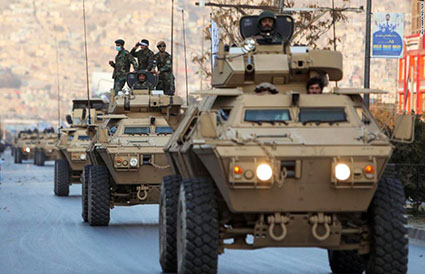Special to WorldTribune.com
When the Taliban forces overran Afghanistan a few months ago, not only did they capture a country continuously in conflict since the initial Soviet invasion in 1979, but they equally seized huge stockpiles of American supplied weapons provided to the defeated Afghan military.
The unexplained and reckless U.S. pullout from the strategic Bagram airbase, a linchpin of allied operations and resupply, fell into the Taliban’s waiting hands like a ripe Central Asian Pomegranate.
Beyond the horrible human and psychological cost since the Taliban takeover, there are estimates that approximately $85 billion in American supplied military equipment, munitions, aircraft, uniforms and vehicles were seized by the fundamentalist Taliban forces. Give or take a few Humvees, that’s a huge weapons cache!

The $85 billion figure would give the Taliban militants one of the world’s largest militaries fresh out of the box.
Equally the value of the booty exceeds the military spending of South Korea by nearly two times ($46 billion), or Japan ($49 billion), Germany at ($53 billion) and Australia at ($27 billion). These are formidable numbers.
Related: Who is Kash Patel? Key Trump intel advisor slams ‘unconditional surrender’ of Bagram Air Base, August 26, 2021
Now I’m the first to caution that the Taliban are not up to the training nor expertise to use much of what they grabbed. They can certainly learn how use some of the seized equipment. Ominously they can sell or barter much of the excess to international arms brokers, Islamic terrorist movements, and rogue regimes. Think about the security ramifications.
We have already seen Taliban military parades in Kandahar city, the spiritual hub of the fundamentalist movement, where Humvees and light armor are on display. We witness Taliban “special forces” wearing U.S. uniforms with high tech night vision gear and brandishing sniper rifles. So, it’s a military given that captured ordinance brings a tough but not very tech-proficient militant force up to a whole new level of capacity.
The $85 billion number was raised by Congressman Jim Banks (R-IN), who said that the U.S. military left behind 75,000 vehicles, 200 aircraft and helicopters, and 600,000 small arms. In fact, the Taliban now has gift wrapped and delivered military equipment giving them a powerful regional punch. Again, it’s fair to say that fortunately the Taliban has neither the pilots nor the maintenance skills or the logistical expertise to operate most seized aircraft. In many cases American forces disabled many helicopters right before the hasty withdrawal. Many aircraft were flown out of the country by Afghan pilots before the collapse.
Still by using subcontractors from places like China or Pakistan much of the equipment can become operable again. The Taliban military has not become a serious risk to the U.S. military, but in the context of the region where they operate in South Asia they have emerged as formidable. Equally much of the night vision goggle technology, helicopter avionics and drone technology has clearly become very likely “available for a price” to some of America’s most serious enemies.
On a less technologically but probably more realistic grounds, what about the windfall of infantry rifles, sniper rifles, handguns, ammunition, and very durable drive around Hummers which give the Taliban an enhanced battlefield firepower and mobility? We are not talking about helicopter gunships but very lethal and maneuverable and ready to use weaponry which add firepower and mobility to Taliban forces. Such small and medium weapons booty allows Taliban a qualitative jump in military capability as well as an excess of material perfectly suited to international arms brokers.
Given the $85 billion number, there has been predictable political pushback by the Biden Administration’s acolytes and the “Beltway experts” to allege the actual amount of lost and captured equipment is much lower by at least half. Possibly. Naturally there’s political spin, “revisiting” and updating of the actual numbers, all couched in Washington’s venerable CYA mode. Nonetheless these are formidable and embarrassing losses.
This does not excuse the shameful and stupid pullout from the Bagram base which opened the treasure trove of military ordinance to a dangerous and rising regional force. But beyond the tragic loss of U.S. equipment, this psychological and political setback has battered America’s standing globally.
John J. Metzler is a United Nations correspondent covering diplomatic and defense issues. He is the author of Divided Dynamism the Diplomacy of Separated Nations: Germany, Korea, China (2014). [See pre-2011 Archives]

 By
By